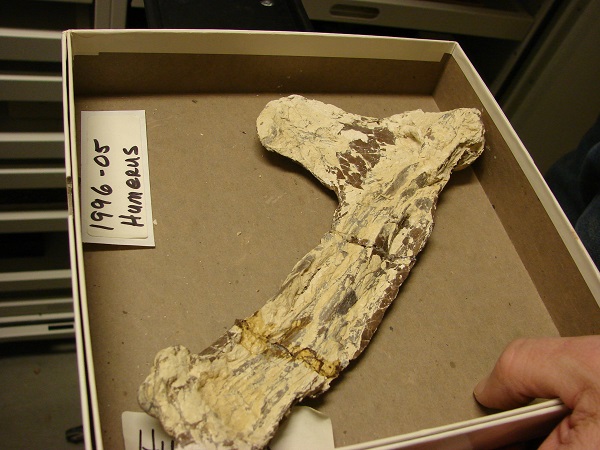Here’s a look at our specimen from last Friday with scale:

This fossil was collected from the Niobrara of Kansas. This wonderful American fossil site was first explored in the 1870s, and has yielded many excellent and dramatic vertebrate specimens: everything from mosasaurs to pterosaurs. This particular specimen is the humerus of a Pteranodon, species unknown.
I don’t know about you, but when I was a kid I loved pteranodons, though like most kids who grew up in the 80s I knew them as pterodactyls. Imagine my chagrin when my three-year-old corrected my nomenclature, thanks to his frequent viewing of PBS’s Dinosaur Train. The shame! However, I did my research (and remembered Stephanie’s blog which discussed this), so I know that pteranodons are not really dinosaurs. Unsurprisingly, my son violently disagrees with me on this point.
Regardless of this dispute, we are in unanimous agreement in my household that these flying prehistoric beasts are awesome. Some of the species that lived in what became the United States were huge, with wingspans up and sometimes even exceeding to six meters. Despite being gigantic and potentially terrifying, fossil evidence indicates that they mostly ate fish, as were abundantly found in the great inland seas that used to lie upon much of the Great Plains. It seems likely that these animals could dive like modern fishing seabirds, and that they flew in a manner similar to the modern albatross: with a lot of dynamic soaring, appearing to glide majestically while using as little energy as possible. Interestingly, most researchers now agree that these animals were quadrupedal when they walked around on the ground, which frankly would be a little creepy-looking.
Many of the fossils from these creatures are found slightly crushed, perhaps because, like other flying creatures, they had pretty delicate bones. However, quite a large number of fossils have been found, over a thousand, which include several articulated specimens as well as skulls. It used to be believed that there were more species of pteronodons than we currently think existed. Why? Because new research suggests that these animals had considerable sexual dimorphism, so it’s likely that individuals once classified separate species were actually males and females of the same species. Researchers now believe that females, which were much smaller, outnumbered males at about a 2:1 ratio, which could indicate that they lived along the shore in large colonies with polygamous males in a manner somewhat similar to modern sea lions.
Dinosaur Train might have the fish and the name right, but I don’t think I’ll burst my kids bubble quite yet regarding the species’ likely family structure.
The winner this week? Frankly, I was impressed at the detail and evidence laid out in many of your proposed answers, but the only person who got it right was Gary! Congratulations, and thanks for playing! If you have a fossil you want to share, send your pictures to me at schoerning at ncse.com.

